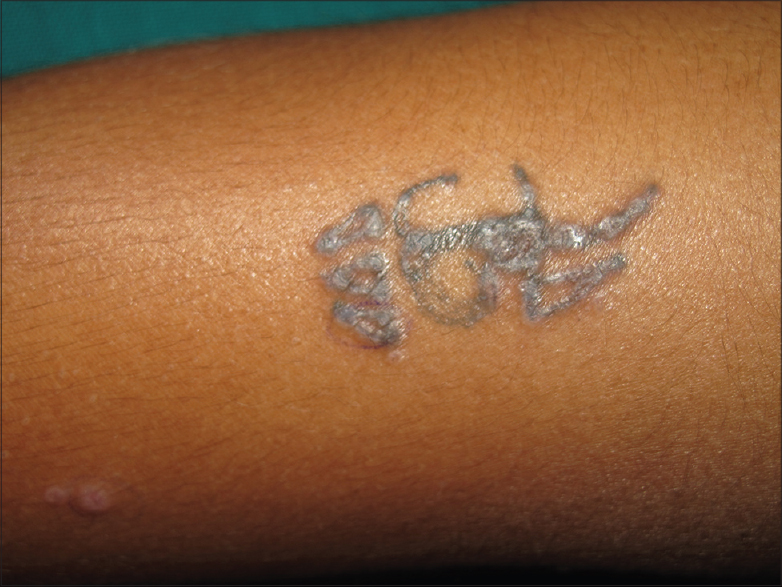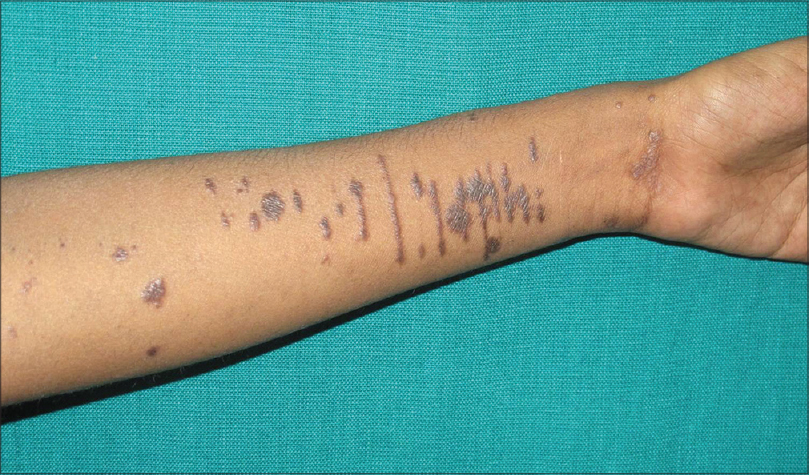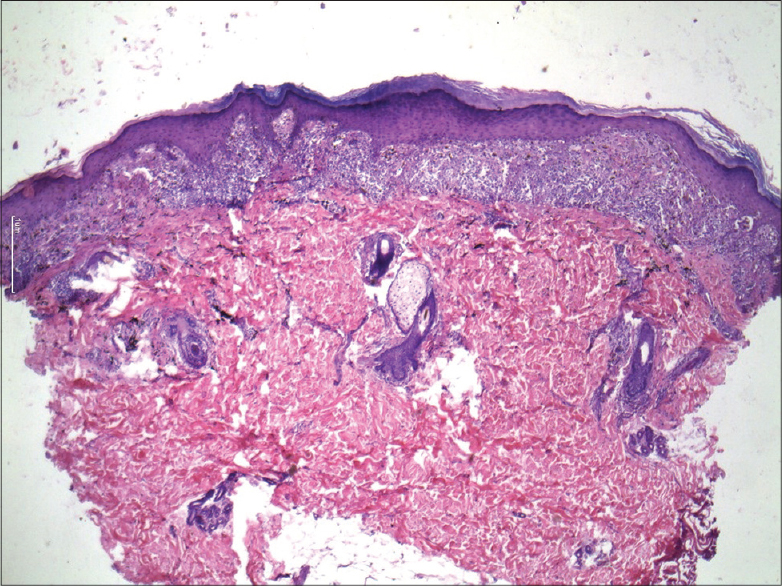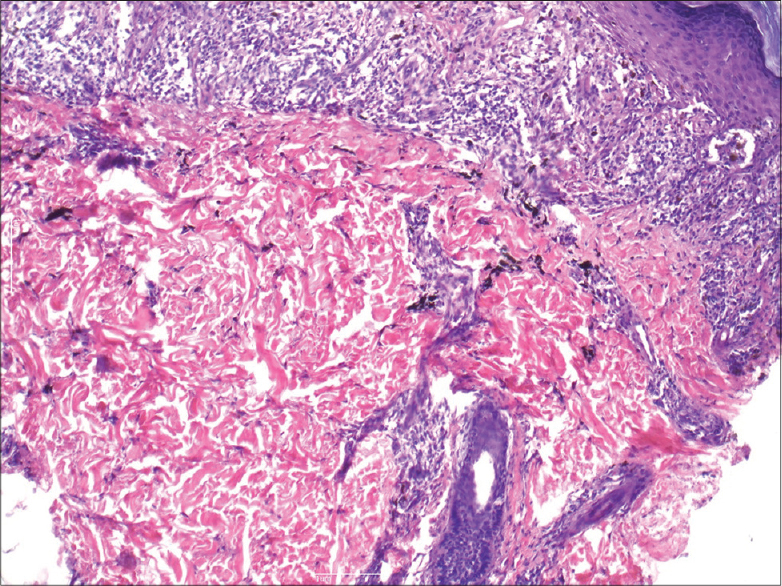Translate this page into:
Generalized lichen planus following tattooing with involvement of old hypertrophic scars: Is it 'Koebner recall?'
Correspondence Address:
Kinjal D Rambhia
Department of Dermatology, Seth GS Medical College and KEM Hospital,Parel, Mumbai, Maharashtra
India
| How to cite this article: Rambhia KD, Chikhalkar SB, Khopkar US. Generalized lichen planus following tattooing with involvement of old hypertrophic scars: Is it 'Koebner recall?'. Indian J Dermatol Venereol Leprol 2015;81:306-308 |
Sir,
Decorative tattooing is regaining popularity and consequently there is a rise in the number of tattoo-associated skin disorders. We came across a case of generalized lichen planus that was triggered by tattooing and also involved an old scar.
A 20-year-old female presented with multiple, dark colored, raised, itchy lesions 4 days after getting a carbon tattoo done on her forearm. The lesions were present all over the body including the tattoo site. On examination, there were multiple violaceous flat topped papules over the upper and lower extremities, including a plaque that had taken the shape of the tattoo [Figure - 1]. Interestingly, similar lesions developed even over 7-month-old hypertrophic linear scars which were present on the left wrist [Figure - 2]. Oral mucosa, genitals, nails, and scalp were normal.
 |
| Figure 1: Violaceous papules coalescing to form a plaque on the tattoo taking its shape |
 |
| Figure 2: Involvement of old hypertrophic scars with violacoeus linear plaques of lichen planus |
Skin biopsy from a papule on the upper extremity showed lichenoid dermatitis with a band like lympho-histiocytic infiltrate in the papillary dermis with a few Civatte bodies at the interface [Figure - 3]. Histopathologic examination of a violaceous papule on the tattoo showed lichenoid dermatitis with lympho-histiocytic infiltrate and melanophages in the papillary dermis. Jet black tattoo pigment unassociated with the lichenoid infiltrate was seen deeper in the dermis [Figure - 4]. A diagnosis of generalized lichen planus, precipitated by tattooing with the involvement of old linear hypertrophic scars was reached.
 |
| Figure 3: Band-like lichenoid infiltrate in the papillary dermis. (H and E, ×100) |
 |
| Figure 4: Jet black tattoo pigment unassociated with the lichenoid infiltrate seen deeper in the dermis. (H and E, ×400) |
Koebner or isomorphic phenomenon is characterized by development of lesions at sites of non-specific trauma during the evolving stages of the disease. [1] The new lesions are clinically and histopathologically identical to those of the diseased skin. It has further been subdivided into two classes: KP-h (Koebner′s phenomenon from history) and KP-e (experimentally induced Koebner′s phenomenon). Our patient had lichen planus lesions all over the body including the tattoo site taking its form and also involving old linear hypertrophic scars. The differential diagnosis of lichenoid reaction to tattoo pigment includes lichen planus, lichenoid reaction and cutaneous lupus erythematosus-like reaction. The occurrence of generalized lichen planus with localization at the tattoo site could be explained on the basis of koebnerisation. The inciting stimulus of tattooing probably caused koebnerisation at the tattoo site and may have altered the epidermal mechanics at the tattoo site causing release of an antigen, which precipitated generalized lichen planus in a predisposed individual.
However, an unusual finding in this patient was the involvement of 7-month-old asymptomatic hypertrophic linear scars, which could not be explained by Koebner′s phenomenon. A hypertrophic scar pathologically is composed of compactly arranged and parallel bundles of thickened collagen with fibroblasts. The pathology is primarily dermal, but may be accompanied by some epidermal hyperplasia at times. The currently recognised pathomechanisms of Koebner phenomenon fail to clarify if the phenomenon may occur in a 7-month-old scar. We assume that there may be a phenomenon of ′Koebner recall′ where development of isomorphic pathologic lesions occurs at the sites of previous trauma probably in predisposed individuals. There may be immunological, vascular or other factors that may be at work even in a dermis with fibroblastic hyperplasia, which are yet to be defined as the causes of this interesting clinical manifestation. Lahiri et al. had described the occurrence of vitiligo [2] and lichen planus [3] along stretch marks. Koebner′s phenomenon seen in recent and old scars in pemphigus, which manifest primarily as epidermal disease, has also been described previously. [4]
| 1. |
Thappa DM. The isomorphic phenomenon of Koebner. Indian J Dermatol Venereol Leprol 2004;70:187-9.
[Google Scholar]
|
| 2. |
Lahiri K, Sengupta SR. Vitiligo developing on striae: An isomorphic phenomenon? Indian J Dermatol 1996;41:70-1.
[Google Scholar]
|
| 3. |
Lahiri K, Malakar S. Lichen planus developing along striae gravidarum. Indian J Dermatol 2004;49:156-7.
[Google Scholar]
|
| 4. |
Cerottini JP, Burren R, Panizzon RG. Pemphigus vulgaris occurring simultaneously on a recent and an old surgical scar due to a Koebner's phenomenon. Eur J Dermatol 2000;10:546-7.
[Google Scholar]
|
Fulltext Views
7,868
PDF downloads
1,575





